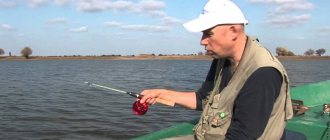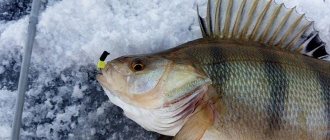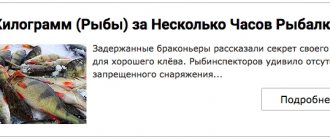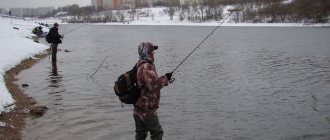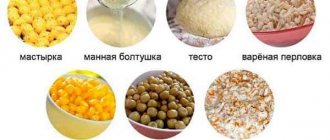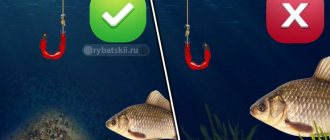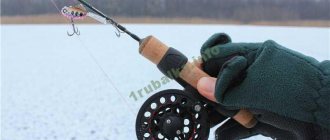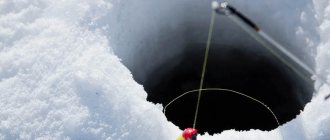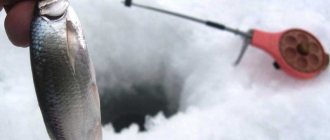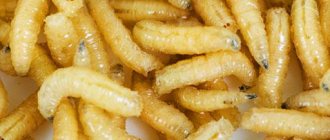To catch even a small perch in winter, certain knowledge and skills are required, since you need to choose the right place for fishing, decide on a catchable bait, and also have sensitive gear.
Winter lures and the subtleties of jig fishing
It is possible to catch perch in winter using various baits. These include:
- Mormyshka , which is a small-sized artificial bait. The material for making such a bait can be lead, tungsten or tin. The jig can have any shape, with a hook soldered into it. Today we know about several of the most common models of jigs.
- Spinner for vertical trolling. This is an artificial bait made of copper, brass or other metal. It is distinguished by a narrow, purlin-shaped body, equipped with a single, double or triple hook.
- Balancer . This is also an artificial bait, cast from lead or tin, shaped like a small fish, with a corresponding coloring. The balancer is equipped with a triple hook attached to the bottom of the bait and one single hook located in front and behind the balancer.
- "Baldu" . This is an artificial bait of a special shape in the form of a cone, in the upper part of which there is a hole through which the bait is attached to the main fishing line. In the same place there are 2 hooks that look in different directions. For greater attractiveness, multi-colored cambrics or beads are placed on the hooks.
- Silicone baits . Typically, twisters and vibrotails measuring 3-5 centimeters with jig heads weighing from 4 to 8 grams are used.
Winter fishing. Perch on a jig.
One of the most common is the jig, as perch is caught with it all winter. The technique of fishing with a jig is not particularly complicated, but it has its own characteristics. As a rule, everyone, even a novice angler, knows the technique of catching perch with a jig.
Unfortunately, without basic skills in using a jig, you shouldn’t count on a significant catch. Therefore, before counting on a catch, you will have to master the technique of guiding the jig.
The game of the jig is associated with the correct and measured actions of the fisherman. For example:
- Firstly, you need to find a place and drill a hole or several holes, and only after that they begin to fish them. Start with the hole that was drilled first. After this, they take out the fishing rod and unwind it, and then lower the jig into the hole and wait for it to fall to the bottom.
- Before the start of the game, the bait is raised from the bottom by 5-7 centimeters and lowered so that it seems to hit the bottom. They do this several times. As a result of such actions, a cloud of turbidity will appear on the bottom, which will definitely attract perch.
- After “knocking” on the bottom, they begin to move the bait. To do this, they lift it from the bottom in steps of 20-25 centimeters, pausing each time. Raise the jig to a height of 1 to 1.5 meters. During the lifting process, the jig is revived by various movements of the fishing rod. These can be either short, high-frequency twitches or low-frequency sweeping movements.
- Having raised the jig in steps to the desired height, it can be lowered in any way: it can itself, under its own weight, sink to the bottom, making certain movements, or it can be slowly lowered to the bottom, with some degree of animation.
Preparing gear for winter fishing
You can catch a predator in winter with a float or nod fishing rod; the choice depends on the type of bait used. In the first case, the equipment consists of a jig, which is tied to a fishing line with a cross-section of 0.1-0.16 mm. You don’t have to use a nod; the bite indicator is a float. Note that it is possible to give the equipment maximum sensitivity if the float is adjusted so that after lowering the bait it disappears under the water by 1-2 centimeters. A bloodworm, maggot, worm, or a combination of these baits is attached to the jig hook.
If you plan to catch a predator with artificial bait (spinner, balancer or baitless jig), then be sure to install a nod 15-20 cm long on the winter fishing rod; the parameter is determined individually based on the weight of the bait. It is important to note that the nod should not bend more than 25-30 degrees under the weight of the bait.
And in conclusion, we note that only a responsible approach to the choice of gear and bait can guarantee a positive result in catching not only perch, but also any other fish in the winter.
Searching for perch in winter
As a rule, small perch prefer to stay in schools, with the exception of large individuals that prefer a solitary lifestyle. At the same time, schools of perch actively migrate through the reservoir in search of food. Therefore, their location in winter depends on many factors, such as the presence of currents, weather conditions, etc. Due to this:
- With the appearance of the first ice, the perch is still in its “home” places, located within the sandy beaches not far from the shore. It feeds at depths of no more than 2 meters in areas where aquatic vegetation is still preserved. Larger bass choose deeper areas where trees are submerged and provide excellent hiding places.
- In the depths of winter, it is difficult to find perch close to the shore. Unless during periods of prolonged warming it rises from the depths to visit shallow waters. And so, here, mainly, there are grass perch, which do not need special wintering conditions. Medium-sized and large perch go to depth, where they will remain there until spring.
- With the arrival of spring, when melted streams begin to bring food and oxygen into reservoirs, the perch comes to life and begins to actively feed. He leaves his former winter shelters and heads to places where streams and streams flow in to find food for himself.
Where to look for perch in winter?
At the beginning and at the end of the winter season, the fished object does not go to depth, it remains in shallow areas. During the day, it can repeatedly go out to feed in the coastal thickets of grass, where it is always full of small fish. That is why after freeze-up and closer to spring, it is better to fish near the coastline at depths of up to 2 meters. If there are creeks or shallow bays overgrown with reeds in the reservoir, it is advisable to start with them, since such places are usually very rich in perch.
In the middle of winter the picture is somewhat different. During the period of the so-called deep winter, striped predators move to depth, and with the end of severe frosts they return to the coastal zone. Mother Winter begins to slowly recede, the sun appears more and more often, and they become more active every day.
Successful catching of perch in winter requires a significant investment of time searching for it. Sometimes you have to drill dozens of holes just to pull out a couple of specimens from one of them. Even if fortune is on the angler’s side and he manages to find a site for a large school, he still continues to wield an ice ax in order to extract the maximum from a promising area. With the right approach, up to 10 individuals can be pulled out of a found school of perch, but then you have to go searching again.
During the cold period, minke whales can peck throughout the entire water area, but at one point it will be rare and weak pokes, and at another point the bite will be so intense that it could be called a zhor.
Experienced fishermen unerringly find such places and try to keep them secret: they go fishing on weekdays, when there are fewer competitors on the ice, fill the holes with snow, immediately hide the catch in a fishing box, and so on. There are fishing spots everywhere, on any river and almost all lakes. But how to find them? Let's try to figure out where perch likes to spend the winter:
- As already mentioned, most of the winter the fished object stays close to the shore, in shallow waters, but shallow water is different. If it is just an underwater plateau with sparse vegetation, then encountering it is unlikely. Another thing is the overgrown sandbank located next to the pit. It is at the exit from the hole (for example, from 5 meters to 1.5 meters) that a school of perch most often stands.
In heavily silted reservoirs, you should look for areas with a hard bottom surface. This could be pebbles, sand, or a concrete slab from a dam. Such a point often turns out to be a real perch Klondike, and then the desire to catch a couple of handsome guys turns into gambling and very prey fishing.- Places whose bottom is strewn with snags, massive stones and other objects that serve as reliable shelter should be considered promising. This is also one of the favorite locations of large perch in winter, and in summer too.
- Sometimes the predator suddenly refuses to peck, although just yesterday it was fully active. It seems that he suddenly up and disappeared. Old holes were checked, many new ones were drilled, and in each there was absolute silence. In such cases, it makes sense to try to cast the tackle at an insignificant depth, where the drill lifts more dirt onto the ice than water. Surprisingly, from a 15-centimeter layer you can get a lot of heads, and not some runts, but quite good ones - up to 300-400 g in weight. What did they forget here? Such strandings cannot be explained by anything other than the presence of fry in it.
First ice: searching for catchable places
Fishing in winter is an active search for fish and perch is no exception. Therefore, fishing comes down to drilling as many holes as possible in a promising place. With the appearance of the first ice, the striped predator is still on the shallows, therefore:
- The distance between the holes should be about 3 meters when fishing with a jig.
- It is advisable, after drilling the next hole, to measure the depth in order to determine the bottom topography.
- It is advisable to find a fall into a hole or just a difference in depth. After this, they begin to play holes further, parallel to the first row, heading in the opposite direction. If the first holes were drilled in the direction from the shore and to depth, then the second row is drilled in the opposite direction, etc.
- They start fishing from the first drilled hole, located in shallow water. If the weather is sunny, then you don’t need to remove the crumbs from the hole, you just need to make a small hole so that the jig can fit through it.
- You should not stop for a long time on one hole; it is enough to make 5-7 lifts of the jig.
- If during this time there are no bites, then you can safely move on to the next hole.
- If a perch bites in any hole, then this place is fished from all sides and, if necessary, additional holes are drilled around this hole.
- The holes where active biting was observed are remembered. There is a high probability that a school of perch will approach here again.
Fishing spots
On the first ice, you need to beware of places near the reeds or rocks sticking out from under the ice crust. You need to be extremely careful at the confluence of streams and rivers: the ice there is always thinner. In general, for any beginner, their first winter fishing is for perch. Even after the freeze-up, this beautiful fish still continues to feed near the shore. At this time, this is where you should look for her. Sometimes the perch is caught not at the very bottom, but at a depth of up to forty centimeters from the lower edge of the ice. Therefore, in the first ice conditions, it is necessary to fish all water layers. But you will have to look hard for the flock.
At the beginning of winter, perch can be very active and actively chase fry. In mid-January, large and medium-sized specimens go into deep holes. However, they will still feed by going out onto the luds. Therefore, it is at a depth of up to five meters that the best January winter fishing will occur. Perch fishing in early and mid-February will also be catchy near the shore, since before the ice breaks up, this underwater inhabitant begins to actively bite again.
Bait for catching perch in winter
When fishing for perch, bait is rarely used. While this is very important for catching roach, it is not important for catching perch. And yet there are cases when the use of bait gives good results, especially in conditions when the perch, for a number of reasons, refuses to attack the bait. According to experienced fishermen, nowadays even perch cannot be caught without bait.
Preparing bait for perch is a responsible and painstaking task. The main thing is to choose the right proportions of all ingredients, although their quantity is always limited. To prepare bait for perch use:
- An ordinary earthworm, which will have to be prepared in the fall. To preserve the worms, they are kept in a cool place in a container with moist soil. Before use, the worms are finely chopped and mixed with breadcrumbs.
- Small bloodworms, which are not used for fishing, are also mixed with breadcrumbs. Before mixing, rub it with your fingers to release its aroma.
Reaction of perch to bait in winter (bloodworms). Bites on a jig
- Fresh pork blood is also used. It is combined with the bread crumb and kneaded to a thick dough-like state. For ease of use, the mixture is wrapped in cellophane, forming small sausages from it. The bait quickly hardens in the cold, and pieces of sausages easily break off and are thrown into the holes.
Winter lures for perch
To catch perch in winter, anglers use a wide range of artificial baits. The most commonly used baits are:
- Jigs, both attached and unattached. The advantage of jigs is that they can be used all winter. More versatile products include small and medium baitless baits that require appropriate play to interest the predator.
- Ice fishing spinners work well for catching both medium and large perch throughout the winter.
- Balancers, which should be classified as a certain type of artificial bait. All balancers resemble a small fish in shape and appearance. The bait is quite catchy, thanks to the peculiarities of the game. The coloring of the balancer can be very diverse.
- The artificial bait “balda” is distinguished by its simplicity. Despite this, it is also distinguished by its enviable catchability. Due to the specifics of fishing on the bulldozer, this bait attracts the striped robber no worse than other, more “advanced” models.
Two ways to make BALDA bait. Winter fishing. Perch.
- Silicone baits, especially recently, have begun to actively replace traditional ones, such as jigs, spinners, etc. These baits serve as an excellent alternative to baits already known and used by fishermen for a long time. Both twisters and vibrating tails can replace both balancers and spinners. In addition, they are not expensive and are affordable for any category of fishermen. In addition, they play more naturally in the water column.
Fishing
The material support for this exit is as follows: the right drill, a scoop, an unhooking hook, two fishing rods - one with a spoon, the other with a dowel. It takes a lot of drilling. This is the requirement of a lake predator - if you want to get acquainted with big fish, don’t be lazy, work. On today's holes, the perch on the lake does not want to take, only small things cling. Maybe on a whim? The range includes lead, dark copper and brass. A leash 5-7 cm long is attached to the main fishing line on top of the bait, about ten centimeters away. On the shank of the hook there is a set of cambrics: red - yellow - black - yellow - red, and on the bend there is a scarlet hair. This type of hook produces 40-60 percent of the fish caught. The same additional hooks are located above the spinners. My old favorite is yellow, light, gliding, with a tail that, by bending it a little, you can change the pattern of the game. This is sometimes a disadvantage of the spinner - if you handle it carelessly, you can damage the tail unnoticed by the eye and thereby disrupt the game, and then wonder why the fish doesn’t bite. Therefore, I made it a rule: when starting fishing in a clean hole, I make several moves on top, visually making sure that the game corresponds to the norm. Well, one more thing that’s unpleasant is that the pike doesn’t let the spoon through and often bites it off without asking, although the lower 30-40 cm of the main fishing line is made of braid. In principle, this is a standard serial spinner and is called “Rybka-2”.
I begin to comb the space on the perch plantation from the side where the wind blows. I throw the caught fish directly onto the ice (if it is not too slippery or snow is falling), then it is clearly visible where and near which hole how many were caught. And I move as if backwards forward, I see all the holes passed, they are under control, otherwise various invaders, some flying, some running, can greatly halve the catch. If only small things come out of the hole, then, as a rule, there is no good perch here and there is nothing to waste time in vain.
What and how to catch perch in winter?
As mentioned above, perch fishing in winter is carried out using jigs, spoons, balancers, “balda” and silicone baits. For example:
- Jigs are baits that require active play. Therefore, the angler must try to keep the bait moving accordingly, rising step by step. There should be a pause after each step.
- Spoons and balancers are distinguished by a different, very peculiar game, carried out by short lifting them with the tip of the rod. Being in free fall, they are able to interest the perch with their play.
- “Balda” is a simple but effective bait, which is shaped like a cone, in the upper part of which the bait is attached to the fishing line. The principle of fishing is to constantly tap on the bottom, followed by raising the turbidity.
A few theoretical calculations
The European “fishing” winter today is increasingly moving closer to January. Now everyone is noting that the first ice in January is far from what everyone is used to. At this time, all the inhabitants of the underwater world switch to the winter period of life. But now it turns out that we have to start the winter fishing season during the deep winter, as it used to be in such days. During this period, scattered schools of perches are noted, which serves as a kind of indicator of the onset of real wilderness.
A large school is detected faster and easier, where the fish are in a state of constant competition for food, so when catching perch in a school, no special skill is required, everything that catches your eye is grabbed: a spinner, a jig or a balancer - it doesn’t matter! At the same time, the hunting predator is completely indifferent to the game of bait. Sometimes you can simply lower winter baits onto the perch a little below the ice edge, and a bite is guaranteed. But such luck does not smile on the fisherman so often.
Jigs for perch
The active perch spends most of the daylight hours searching for prey and chasing it. The main prey of predators in large bodies of water are small fish - bleak, roach, and verkhovka. It is very difficult to determine the direction of movement of a school of hunting perch. Running and drilling dozens of holes is not possible not only for the common man, but also for any athlete, so during this period for many fishermen, catching perch in winter involves catching passive perch.
The behavior of a solitary perch is fundamentally different from the behavior of its schooling relatives. With low activity, he practically does not feed. But you shouldn’t think that he doesn’t bite at all. If the position of the bait on the perch is such that it will not be difficult for him to grab it, then the fish will grab the offered bait, and what is also important is what its game and type are. On the other hand, no matter how good the bait and game itself may be, they are useless if there are no fish under the hole. In this case, the fisherman will be left with nothing.
Of course, these are extreme options. You can always find active fish in sufficient quantities in a reservoir, regardless of the time of year.
Winter baits for catching perch
Perch, as you know, is a predatory fish, so to catch it you should use bait of animal origin. To catch perch in winter you can use:
- Bloodworm, which is one of the most versatile baits for perch at this time. It can be used at any time.
- Burdock fly larva. Perch will also be actively caught with this bait.
- Dung worm. The only problem is that this type of bait is difficult to get in winter, but you can count on frequent and effective bites. Many fishermen prepare dung worms in the fall, providing suitable conditions for their storage.
- Live bait, but first you need to catch a small fish. A fairly large perch can bite on live bait.
Perch fishing strategy
By and large, there are not so many places where the striped predator is found:
- flooded coastal bushes;
- fallen tree trunks that are in water;
- areas along the perimeter of the islands and various types of underwater elevations;
- interbranch channels;
- grassy shallows and deep dumps.
Simply put, it can be found where it is easier for it to find prey. Once the freeze-up begins, you can wait a week, and now all the named places are clearly distinguished on the ice surface by a large number of holes drilled in the ice thickness. Most people think that after a couple of weeks you won’t find any fish here, all the active fish have been killed and there’s nothing left to do here. But at the same time, someone constantly pulls prey out of a hole in such a place, and someone is simply left with nothing, being an observer of a more successful neighbor. What does this depend on? It turns out that it is not enough to “hatch” the catch, you need to be able to connect the place and time into one whole so that winter fishing for perch becomes successful.
Catching perch with a jig
When using reelless jigs for perch, you can start your “working day” with fishing in grassy shallow water, and only then move on to your favorite places. In this case, there is absolutely no need to sit in one place. And in the evening you can return to shallow water again. This method of fishing, where baitless jigs for perch serve as the main bait, replacing live bait, brings good results compared to sitting for a long time in one place.
In the morning and evening hours, you can often catch impressive-sized perches in shallow grassy waters. But the bite is limited to about forty minutes at sunrise and about thirty minutes the perch bites at sunset, which indicates that it comes here to rest, having time to feed on smaller specimens of its relatives. During the day, you should check familiar fishing spots, where there can also be a very good catch. At the same time, despite the relative diversity of possible fishing spots, one cannot talk about the advantage of one or another of them. The fact is that a perch can appear unexpectedly for a fisherman in places where some time ago there was no hint of its presence.
Active bites last for about twenty minutes, then the bite stops abruptly, but throughout the day the predator may well still appear here. Such entry of perch to the same places can be observed more than once a day.
Jigs for perch
When choosing jigs for catching perch, you should be guided by certain factors. For example:
- The presence of current and fishing depth. If the fishing depth is not large, then it is better to take baits no larger than 2 mm in size, and in areas with depths of up to 4 meters, as well as in the presence of a strong current, heavier and larger jigs, up to 4 in size, are suitable mm.
Catching perch in winter with a jig
- Light level. If the ice is thin and it is clear outside, then the light level allows you to use small jigs of dark shades, which are clearly visible to perch in such conditions. When the ice is thick and it’s cloudy outside, it is better to give preference to baits that have bright colors.
- In conditions of the first and last ice, perch actively bites both small and larger jigs. In the depths of winter, small, no-attachment jigs are better suited.
For the spinner
In summer, perch fishing with a spinning rod or float rod is considered the most successful. The first tackle can also be used in the winter season. But this is only possible if the fast current prevents the reservoir from freezing.
However, the best winter fishing for perch is fishing with a spoon or jig. It begins with drilling holes. If an angler has discovered a school of perch, then the most important factor for luck will be the speed of fishing.
Spinner is truly an irreplaceable bait. Its optimal weight makes it possible to deliver the fishing line to the right place. The benefits of such perch fishing are obvious. The speed of searching for fish is much higher (compared to a jig). In addition, perch reacts to the spoon much faster, since its size is larger. This means that vibrations of sound and water, which the prey senses at a sufficient distance, force it to swim even from afar.
And in windy or frosty weather, playing with a spinner is less difficult than with a jig. For winter perch, tin, silver, brass or copper options are better. According to experienced fishermen, both purchased and homemade spoons have proven themselves to be quite good.
Ready-made options can be improved by bringing them to the desired state by changing the bend or shifting the center of gravity using solder. Such modifications are necessary so that the spoon makes oscillatory movements and does not just lie on the bottom.
In this case, color does not matter much, although it has been noted that matte options are inferior compared to shiny ones.
Tactics for catching perch in winter with a jig
Effective fishing at any time of the year, including winter, depends on several factors, such as:
- Searching for a promising location, which boils down to drilling a large number of holes, determining the depths, which will give a complete picture of the bottom topography.
- If the reservoir is known, then the task can be significantly simplified, but if it is unfamiliar, then finding a fish site can take a lot of precious time.
- After this, the fishing of the drilled holes begins with various baits and various wiring techniques.
- Fishing can be more productive if you feed each hole. Moreover, you don’t need to use a lot of feed. It is enough to pour a pinch of bait into each hole. After the bite begins, the amount of bait can be increased.
Spoons for perch
There are a huge variety of artificial baits such as spinners for catching perch, but among them there are some that are quite catchy. At the same time, they differ in both shape and size.
- Size. For catching perch in winter, spoons with a length of 2 to 7 cm are mainly used. As a rule, smaller baits are used for catching small perch, and larger baits are used for catching larger specimens. Naturally, larger baits are suitable for fishing in the current or at depth.
- Color. Lighter lures work well in conditions where there is no sun or in turbid water conditions. Darker baits should be used on clear sunny days in clear water conditions.
- Form. Spoons with a wide blade are more catchy in conditions when the perch is active, especially on the first and last ice. Spoons with a narrow blade are designed to activate passive bass in the dead of winter.
Among the huge variety of winter spinners for catching perch, the following models should be noted:
- "Carnation."
- "Triple-sided".
- "Tetrahedron".
- "Dovetail".
What to feed perch in winter
Regardless of whether you expect to catch large or small perch in winter, you should choose standard bait. It could be bloodworms or worms. On reservoirs with a current you cannot do without feeders. The manipulation should be performed no more than once every 15 minutes.
There are fishermen who advise using dry albumin or frozen blood as bait. These “delicacies” are lowered into the hole. It must be said that the fish can really actively begin to swim up and happily consume the offered delicacies, but after that it is not a fact that it will eat the baits offered to it. Therefore, it is better to use something more traditional.
Read more about catching perch with a reelless bait on the first ice. An effective and proven method.
Catching perch in winter is a wonderful activity for many fishermen. And to make it even better, you need to follow simple recommendations and patiently wait for your trophy.
Balancers for perch
When and how the weight and size of balancers are used:
- For catching small-sized perch, narrow balancers weighing from 3 to 5 grams and up to 4 centimeters in length are suitable.
- For catching large perch, models weighing up to 7 grams and up to 6 centimeters in length are used.
- When fishing in the current, baits are used that weigh at least 10 grams and are up to 9 centimeters long.
Balancers for perch. Search balancers video
Coloring
Balancers for perch differ in two main colors:
- Natural ones that match the colors of small fish such as bleak, redfish, roach or perch. Such colors are considered very catchy throughout the winter.
- Unnatural, bright colors that also actively catch perch at depths of up to 10 meters, or even more.
For perch and roach
First of all, maggots are suitable for catching perch or roach. Especially for perch. And this despite the fact that in the summer, in many reservoirs, perch completely ignores maggots. Bream also reacts to this type of bait, but not always and not everywhere. Although the “bloodworm + maggot” sandwich can provoke a bream to bite even in the absence of a bite.
Perch and roach respond well to winter maggots
In general, in winter it is very convenient to fish for maggots, especially in cold weather or when constantly moving from hole to hole. One way or another, the maggot does not lose to the burdock in anything.
For fish, maggots are as common as caddis flies, bloodworms, leeches and other inhabitants of water bodies. There are many species of flies in the world, most of which live directly near water bodies.
That is why fly larvae are well known to fish. Most likely, the larvae of different types of flies differ in taste, but for fish this does not play a significant role. For them (especially in winter), the nutritional value of food is much more important. And in this matter, maggots are almost in first place, because the larvae contain about 65% protein.
The most productive periods for perch fishing in winter
Fishing for perch in winter is characterized by the inconstancy of its bite throughout the winter period. For example:
- First Ice . Characterized by strong perch biting activity. This period lasts for two weeks after the reservoirs are covered with a stable layer of ice, 8 to 10 centimeters thick. If the winter is not cold, then this period can last all of 3 weeks, and if it is too cold, then this period is naturally shortened.
- Glukhozimye . During this period, the ice is quite thick, and algae begin to rot in the water column, which leads to a lack of oxygen. During this period, the perch does not behave as actively as on the first ice. In the wilderness, small jigs without attachments work well. It should be remembered that the perch is mainly found at depth.
- The last ice . This period is characterized by the fact that oxygen begins to enter the water through gullies that form in areas of great depth, where the ice thickness was less. During this period, a hungry perch begins to peck at any bait.
Features of fishing during these periods
For each period, it is important to select equipment and decide on fishing tactics. For example:
- In conditions of first ice, when the perch has not yet left the coastal zone, spoons and balancers are used to catch it.
- In the dead of winter, the perch has already moved to depth and from there it can be reached with baitless jigs, as well as spinners for vertical trolling.
- In conditions of the last ice, perch begins to return to the coastline, and is also found at the mouths of rivers and small rivers. During this period, it is caught using any type of bait, including jigs.
The best time to catch big bass is in winter
To catch a large specimen, you need to know what depth the fish prefer, what distance the perch likes from the surface of the water. The fish visits shallow water areas at dawn or in the evening to get food.
Perch is a predator that eats small relatives; its diet also includes larvae and insects.
In the cold season, it gathers in flocks and descends to the depths to overwinter.
After freezing, the fish begins an active search for food. This period lasts as long as there is a large amount of oxygen in the water. The most difficult time to catch it is in the middle of winter. When using wobblers, silicone baits and metal spoons, catching perch becomes more effective.
After the water level has dropped, the fish tends to go deeper. To do this, it selects places rich in various vegetation, branches and snags, with a muddy or rocky bottom. It prefers activity during daylight hours, but the perch does not bite at night.
With the onset of cold weather, the fish move to bays and bays. It is not easy to lure a predator out of there, but hunger forces it to rise to the surface from time to time in search of food.
The main principles that should be followed when fishing are the ability to wait and the availability of bait. Scented baits are suitable.
Catching perch in the middle of nowhere
Catching perch in the middle of nowhere, when there are severe frosts outside, piercing winds and heavy snowfalls, is the lot of real avid fans of winter fishing. Not only is it freezing outside, you still need to find fish, and to find them you need to drill dozens of holes. It’s good if you have an echo sounder and with its help you can quickly find a deep place. The task is also simplified if fishing is carried out in a familiar body of water, where all depths are known. Since the fish are not active during this period, the movements of the bait should be smooth.
Video course: Catching perch in winter. A view from under the ice. Very useful for amateur fishermen
If the bite is sluggish and inactive, then you can resort to feeding the holes, and several bloodworms are attached to the hook of the jig.
Deaf winter and its features
In the wilderness, perch greatly reduces activity and moves further from the coastline. He looks for places where the water is warmer and there is more oxygen. Only small ones can be found near the shore, and large perch are more likely to be attacked along the lower edges of dumps, in holes, and channel ditches at sufficient depth. During this period, another feature of perch fishing in winter plays a special role - the dependence of the bite on atmospheric pressure. Activation is noticed at differences: while the pressure changes, there is a catch; The barometer needle stops - the fish freezes. With long-term stable pressure, the perch also bites consistently. In general, making predictions in the wilderness is a thankless task. It is very difficult to guess at what time of day and what bait the perch will go for. In order not to be left without fish, you can use the advice of the master of sports in sports fishing, Yuri Petrash: 1. On the reservoir, using a depth gauge, you can find an edge with a depth of 2.5 meters. 2. 10 holes are drilled along the edge at intervals of 5-7 meters. Each hole is fed with bloodworms. If there is a current, it is better to put the fertilizer directly on the bottom using a feeder. 3. Take a tackle with a fishing line 0.08 thick and a Tula jig made of chiseled tungsten weighing 0.3 grams and a nod of about 7 cm. Attach a bloodworm. 4. Clear the hole well of ice, lower the bait, hit the bottom with the jig 3 times, make three smooth lifts and start retrieving. If a perch stands in this place, it immediately responds. If not, they never return to this place. 5. When small change begins to sit on the hook, change the hole. When leaving for a new place, the old hole still needs to be fed so that the bite resumes. Advice! One of the most catchy elements of gear for ice fishing in the deep winter is the “devil” perch bait. You can buy it or make it yourself.
